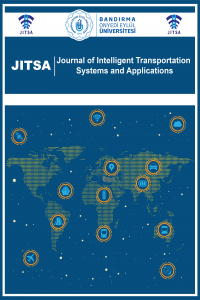Sürdürülebilir ulaşımda önemli bir yere sahip olan bisikletin Gams küme kapsama modeli ile konumlandırılması: Gebze Teknik Üniversitesi örneği
Kentsel genişlemenin birçok olumsuz etkisi olduğu bir gerçektir. Artan insan nüfusu ile birlikte yerleşim alanları gün geçtikçe daralmaktadır. Araştırmalar yolların yanlış yapılandırılmasından dolayı meydana gelen kazalarda artış olduğunu göstermektedir. Bundan dolayı, hem ulaşım hem de çevrede sürdürülebilir iyileştirmeler konusuna önem verilmesi gerekmektedir. Sürdürülebilirliğe adaptasyon ile ilgili yapılan yanlış uygulamalar insanların yaşam kalitesini büyük oranda düşürebilir. Son yıllarda sürdürülebilir ulaşım kapsamında bisiklete verilen değer artmıştır. Çevre dostu ve düşük maliyeti olan bisikletler bunda etken bir sebep olarak görülmüştür. Bu çalışmada, üst düzey modelleme yapabilen Gams programından faydalanılmıştır. Üniversite içerisinde birçok bölüm bulunmaktadır ve gün içerisinde diğer bölümlere gitme ihtiyacı için bisiklet destekleyici durumdadır. Fakat bölümler arası uzaklıklar birbirinden farklıdır. Bu yüzden, diğer bölümlere ulaşma süreleri de değişiklik göstermektedir. Ayrıca, birbiriyle bağlantılı durumda olan bölümlere minimum ulaşım kriteri göz önünde bulundurularak, Gams matematiksel programlama yoluyla kilit noktaların belirlenmesi amaçlanmıştır. Program çıktısına göre, bu alanlarda kaç tane ana durak istasyonu kurulacağı öngörülmüştür. Özetlemek gerekirse, Gams programından elde edilen sonuçlar yerleşim alanındaki planlama konusuna katkı sağlama açısından bir rehber niteliğindedir.
Anahtar Kelimeler:
Sürdürülebilir ulaşımda bisiklet, sürdürülebilirlik, küme kapsama
___
- [1]. Frank, L. D.; Sallis, J. F.; Conway, T. L.; Chapman, J. E.; et al. Many pathways from land use to health. American Planning Association.Journal of the American Planning Association, 2006, 72(1), 75-87.
- [2]. Moeur, R. C.; P.E. Rolling into the future: Emerging resources and new initiatives for bicycle transportation. Institute of Transportation Engineers. ITE Journal, 2008, 78(5), 20-23.
- [3]. Parker, H.; Fields, D.; A.I.C.P. Campus controls. Planning, 2012, 78(2), 7-11.
- [4]. Velazquez, L.; Munguia, N. E.; Will, M.; Zavala, A. G.; et al. Sustainable transportation strategies for decoupling road vehicle transport and carbon dioxide emissions. Management of Environmental Quality, 2015, 26(3), 373-388.
- [5]. Khafian, N. The efforts of handling transportation problems in dki jakarta through sustainable transportation policy. Bisnis & Birokrasi, 2013, 20(3), 179-185.
- [6]. Schoner, J. E.; Levinson, D. M. The missing link: Bicycle infrastructure networks and ridership in 74 US cities. Transportation, 2014, 41(6), 1187-1204.
- [7]. De Waai, L. How the bicycle can enhance sustainable transport. Civil Engineering : Magazine of the South African Institution of Civil Engineering, 2009, 17(8), 26-29.
- [8]. Mateo-Babiano I.; Bean R.; Corcoran J.; Pojani D. How does our natural and built environment affect the use of bicycle sharing? Transportation Research Part A, 2016, 94, 295–307.
- [9]. Kahn, R.; P.E. Bicycle sharing in the U.S.A.: state of the art. Institute of Transportation Engineers. ITE Journal, 2012, 82(9), 32-36.
- [10]. Midgley P. BICYCLE-SHARING SCHEMES: ENHANCING SUSTAINABLE MOBILITY IN URBAN AREAS. UNITED NATIONS DEPARTMENT OF ECONOMIC AND SOCIAL AFFAIRS. Commission on Sustainable Development Nine teenth Session New York, 2011, 2-13.
- [11]. Faghih-Imani, A.; Eluru, N.; El-Geneidy, A. M.; et al. How land-use and urban form impact bicycle flows: evidence from the bicycle-sharing system (BIXI) in Montreal. . Journal of Transport Geography, 41, 2014, 306-314.
- [12]. Bullock, C.; Brereton, F.; Bailey, S. The economic contribution of public bike-share to the sustainability and efficient functioning of cities. Sustainable Cities and Society, 2017, 28, 76–87.
- [13]. Singhal, N.; Gupta, H. Environment sustainability drivers in indian business schools. IPE Journal of Management, 2016, 6(1), 34-45.
- [14]. Ekins, P.; Simon S.; Deutsch L.; et al. A framework for the practical application of the concepts of critical natural capital and strong sustainability. Ecological Economics, 44, 2003, 165-185.
- [15]. Mani, V.; Agrawal, R.; Sharma, V. Social sustainability in the supply chain: Analysis of enablers. Management Research Review, 2015, 38(9), 1016-1042.
- [16]. Sharma, S.; Ruud, A. On the path to sustainability: Integrating social dimensions into the research and practice of environmental management. Business Strategy and the Environment, 2003, 12(4), 205.
- [17]. Boström, M. A missing pillar? Challenges in theorizing and practicing social sustainability: Introduction to the special issue. Sustainability : Science, Practice, & Policy, 2012, 8(1). doi:http://dx.doi.org/10.1080/15487733.2012.11908080
- [18]. Gqaji, A. Can the bicycle become a sustainable transport mode in south africa? Civil Engineering : Magazine of the South African Institution of Civil Engineering, 2010, 18(7), 35-38.
- [19]. Pion, M.; Cline, A. R. Promoting equality through bicycling education in the united states. Institute of Transportation Engineers. ITE Journal, 2016, 86(1), 42-47.
- [20]. Hampel, G.; Zsótér, B. BICYCLE TRANSPORTATION - RESULTS OF A SURVEY IN SZEGED, HUNGARY. Quaestus, 2016, (8), 195-209.
- [24]. UNECE Statistical Database. Erişim adresi: https://w3.unece.org/PXWeb/en
- [21]. Soroudi, A, Power System Optimization Modeling in Gams, 2017.
- [22]. Kabak, Ö. EMM3208 Optimizasyon Teknikleri. https://web.itu.edu.tr/kabak/dersler/EM302/pdf/YAII_h03_gams.pdf
- [23]. Küçükkoç İ.Optimizasyon Teknikleri http://ikucukkoc.baun.edu.tr/lectures/EMM3208/EMM3208W7.pdf
- ISSN: 2636-820X
- Yayın Aralığı: Yılda 2 Sayı
- Başlangıç: 2018
- Yayıncı: Bandırma Onyedi Eylül Üniversitesi
Sayıdaki Diğer Makaleler
Deniz Çevresi İzleme Amaçlı Kullanılan İnsansız Suüstü Araçların SWOT Analizi
Mükemmel/İdeal Şehir içi Ulaşım Sisteminin Diğerleriyle Karşılaştırılması: Toplam Seyahat Zamanları
Akıllı ulaşım sistemleri(AUS) uygulamalarının sektörlere göre dağılımı
Toplu Ulaşımda Akıllı kart Kullanımının Değerlendirilmesi ve Seul Örneği
